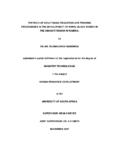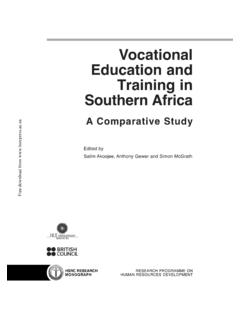Transcription of 15 Zambia - SARUA
1 10515 Zambia Compiled by Godfrey Hampwaye and Liberty MweembaCouNTry CoNTexT sTaTisTiCsPopulation: million (2011) GDP per capita: US$1 238 (2010)Human development index: : 14% (2006 est.) Key economic sectors: mining, agriculture, manufacturing, tourism Principal exports: cobalt, copper, cotton, flowers, electricityHIV and AIDS prevalence: (2009 est.)Gross primary enrolment ratio: 115% (2010) Gross secondary enrolment ratio: 28% (2002)Gross tertiary enrolment ratio: 2% (1999) Country context data were obtained from a variety of sources: CIA (2012), SADC (2007), UNAIDS (2011), UNDP (2011), UNESCO (2011).
2 Zambia is a landlocked country in Southern Africa, with a tropical climate. It consists mostly of plateau, with some hills and mountains, dissected by river valleys. With an area of 752 614km2, it is the 39th-largest country in the world, slightly larger than the US state of Texas. According to the 2010 population census, the total population is 13 046 508 (CSO 2011). Zambia is one of the most urbanised countries in sub-Saharan Africa, with 44 per cent of the population concentrated in a few urban areas along the major transport corridors, while rural areas are sparsely populated.
3 Unemployment and under-employment are serious problems in the urban areas, while the majority of Zambians in rural areas depend on subsistence farming (CIA 2008; Bloom, Cunning and Chan 2006).Historically, the Zambian economy has been based on the copper mining industry. Output of copper fell to a record low of 228 000 metric tons in 1998 after a 30-year decline due to lack of investment, low copper prices and uncertainty over privatisation. In 2002, following the privatisation of the industry, copper production rebounded to 337 000 metric tons.
4 Improvements in the world copper market have magnified the effect of this volume increase on revenues and foreign exchange earnings (CIA 2008; Bloom, Cunning and Chan 2006).The Zambian government is pursuing an economic diversification programme to reduce the economy s reliance on the copper industry. This initiative seeks to exploit other components of Zambia s rich resource base by promoting agriculture, tourism, manufacturing, gemstone mining and hydro-power. Agriculture plays a very important part in the economy, providing many more jobs than the mining industry.
5 Zambeef is the leading Zambian private company in agri-business, with over 4 000 employees and a total land capacity of about 6 500 hectares (5 000 irrigated and 1 500 non-irrigated). Some of the agricultural outputs from agri-processing include cattle by Zambeef, pork by Master Pork, chicken by ZamChick, eggs by ZamChick Egg, feedstock by Novatek and edible oil by Zamanita. Other agriculture-related products are dairy products, leather and fish. Zambeef operates eight abattoirs, four farms and numerous retail stores (also in co-operation with Shoprite) and a fast-food chain (ZamChick Inn) throughout the country (GRZ 2011).
6 A Profile of Higher Education in Southern Africa Volume 2106In 2003, exports of non-metals increased by 25 per cent and accounted for a 3 per cent overall increase in all export earnings to 38 per cent. The Zambian government has recently granted licenses to international exploration companies to prospect for minerals such as nickel, tin, copper and uranium. It is expected that nickel will take over from copper as the country s top metal export. In 2009, Zambia was adversely affected by the world economic crisis. However, the economy has been improving, as observed in the June 2011 Euromoney Country Risk (ECR) rankings, in which Zambia was ranked the 112th safest investment destination in the world, moving 14 places up the table (ECR 2011).
7 Higher education landscapeThe three public universities in Zambia operate under legislation that makes them responsible to parliament through the Ministry of Education. The legislation confers academic freedom and managerial autonomy on each university. Academically, each university is responsible for determining its own programmes of instruction at undergraduate and postgraduate level, determining and regulating the requirements for admission, regulating and conducting examinations, and conferring degrees and other awards.
8 The universities are also responsible for promoting, co-ordinating and controlling the direction of academic research. Each university engages its own staff, manages its own internal and institutional affairs, charges fees and carries out its business as it perceives fit. The universities derive their income from annual government grants, student fees and income-generating historical overview of higher educationAt independence in 1964, Zambia had just over 100 university graduates and no public university. The University of Zambia , the first public university, was established in 1966 and opened its doors to 310 students in its first year.
9 By 1994, the University of Zambia and the Copperbelt University had a total enrolment of almost 6 000 students, with 4 592 enrolled at the University of Zambia and 1 393 enrolled at the Copperbelt University. By then both universities had cumulatively awarded more than 16 000 degrees, diplomas and certificates (UNESCO 2007; Bloom, Cunning and Chan 2006). The University of Zambia is the country s largest university with a student population of over 15 000 on its two campuses. The main campus is called the Great East Road Campus and is on the Great East Road about 7km from Lusaka.
10 The second campus is the Ridgeway Campus in Lusaka, located at the University Teaching Hospital (popularly known as UTH). This campus specifically houses students pursuing courses in medical and pharmacological fields. The University of Zambia has nine Schools (known in some universities as faculties): Agricultural Sciences, Education, Engineering, Humanities and Social Sciences, Law, Medicine, Mines, Natural Sciences, and Veterinary medicine. The Copperbelt University (CBU) is located in the city of Kitwe and has four Schools: Business Studies, Environmental Studies, Forestry and Wood Sciences, and Technology.




